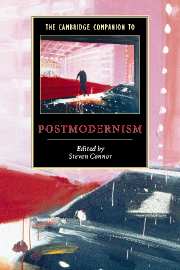Book contents
- Frontmatter
- Introduction
- 1 Postmodernism and philosophy
- 2 Postmodernism and film
- 3 Postmodernism and literature
- 4 Postmodernism and art
- 5 Postmodernism and performance
- 6 Postmodernism and space
- 7 Science, technology, and postmodernism
- 8 Postmodernism and post-religion
- 9 Postmodernism and ethics against the metaphysics of comprehension
- 10 Law and justice in postmodernity
- Further reading
- Index
- Sereis List
4 - Postmodernism and art
postmodernism now and again
Published online by Cambridge University Press: 28 May 2006
- Frontmatter
- Introduction
- 1 Postmodernism and philosophy
- 2 Postmodernism and film
- 3 Postmodernism and literature
- 4 Postmodernism and art
- 5 Postmodernism and performance
- 6 Postmodernism and space
- 7 Science, technology, and postmodernism
- 8 Postmodernism and post-religion
- 9 Postmodernism and ethics against the metaphysics of comprehension
- 10 Law and justice in postmodernity
- Further reading
- Index
- Sereis List
Summary
Perhaps a failure, certainly a problem
Writing on “postmodernism” at the beginning of the twenty-first century is an uneasy business, and perhaps particularly so in relation to the visual arts. The term has undoubtedly gained a certain cultural currency, but its meaning (or meanings) and value seem in many ways more obscure than ever. The most secure usages - in dance and in architecture - seem to pick out a moment of something like style in ways that make it little more than one further moment within the general artistic logic of modernism, while the attempts to use it in ways that pick out some presumably deeper challenge to modernism over all do not seem to have succeeded in doing so. The phrase “postmodern art” seems for the most part to have run aground somewhere between these two possibilities, having secured no particularly strong style or period usage but also having failed to secure any broader or deeper generalization of postmodernism. At times it can seem that all that is actually left is a sort of gesture toward some general social or cultural fact that is taken to be peculiarly resistant to, or evasive of, the kinds of fuller parsing that accompany our usage of terms such as “modern” or “modernist.” This may sometimes function more or less successfully as a password of sorts, but it also feels like a word or phrase whose grammar has more or less mysteriously failed it. One might, of course, hope that what appears as its failure is in fact, but unrecognizably, its actual grammar.
- Type
- Chapter
- Information
- The Cambridge Companion to Postmodernism , pp. 82 - 96Publisher: Cambridge University PressPrint publication year: 2004
- 1
- Cited by



